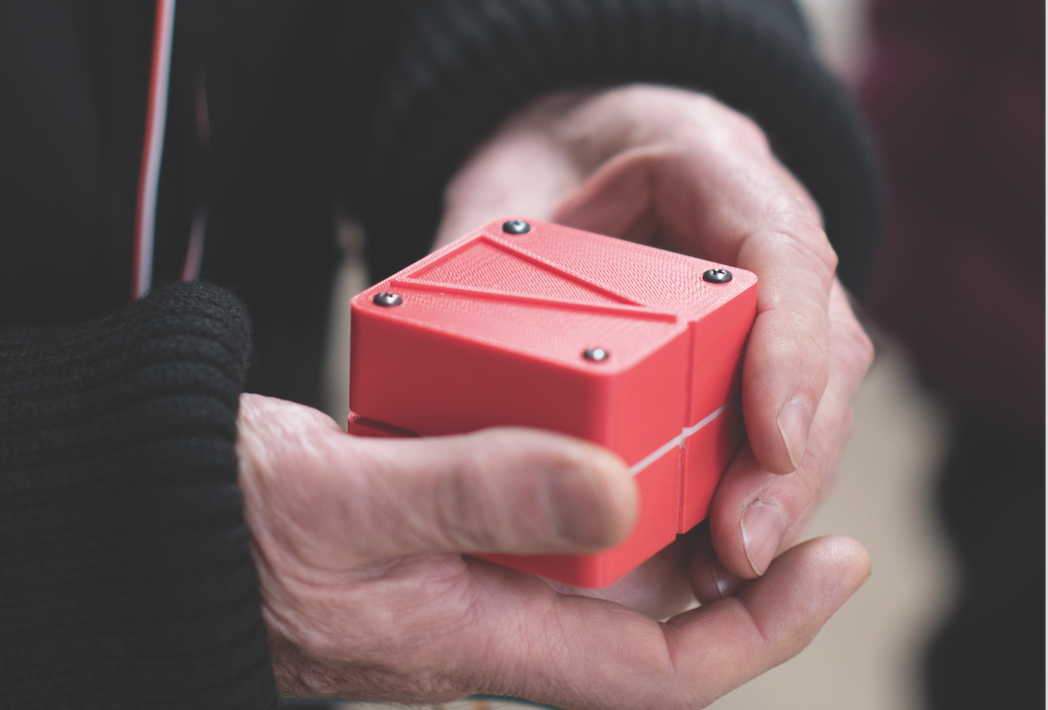Despite its small size and simple appearance, Animotus is simultaneously a feat of engineering, a work of art, and a potentially transformative community service project.
Adam Spiers, a postdoctoral researcher in Yale University’s department of mechanical engineering, has developed a groundbreaking navigational device for the visually impaired. Dubbed Animotus, the device can wirelessly locate indoor targets and changes shape to point its user in the right direction towards these targets. Unlike devices that have been created for the visually impaired in the past, Spiers’ device communicates with its users by way of gradual rotations and extensions in shape. This subtly allows the user to remain focused on his or her surroundings. Prior iterations of this technology were distracting in their vibrations and sounds, taking focus away from the environment.
Spiers created Animotus in collaboration with Extant, a British theater production company that specializes in performances for the visually impaired. The device has already been successful in Extant’s production of the interactive play Flatland, and with further research and development Animotus may be able to transcend the realm of theater and dramatically change the way in which the visually impaired experience the world.
Most haptic technology, or systems that utilizes our sense of touch, operate through the vibration of a cell upon a particular stimulus. The potential applications of haptics, however, are far more complex and important than mere notifications. Spiers was drawn to the field of haptics for the implications on medical and assistive technology. In 2010, he first collaborated with Extant to apply his research in haptics to theater production.
To facilitate a production of The Question, an immersive theater experience set in total darkness, Spiers created a device called the Haptic Lotus, which grew and shrunk in the user’s hands to notify him when he was nearing an intended destination. The device worked well, but could only alert users when they were nearing their targets, instead of actively directing them to specific sites. As such, the complexity of the show was limited.
Thanks to Spiers’ newly designed Animotus, Extant’s 2015 production of Flatland was far more complex. Spiers and the production team at Extant sent four audience members at a time into the pitch-black interactive set, which was built in an old church in London. Each of the four theatergoers was equipped with an Animotus device to guide her through the set and a pair of bone-conducting headphones to narrate the plot. Animotus successfully guided each audience member on a unique route through the production with remarkable accuracy.
Even more impressive, Spiers reported that the average walking speed was 1.125 meters per second, which is only 0.275 meters per second slower than typical human walking speed. Furthermore, walking efficiency between areas of the set was 47.5 percent, which indicates that users were generally able to reach their destinations without excessive delay.
The success of Animotus with untrained users in Flatland left Spiers optimistic about future developments and applications for his device. If connected to GPS rather than indoor navigational targets, perhaps the device will be able to guide users outdoors wherever they choose to go. Of course, this introduces a host of safety hazards that did not exist in the controlled atmosphere of Flatland, but Spiers believes that with some training, visually impaired users may one day be able to confidently navigate outdoor streets with the help of Animotus.
Spiers is particularly encouraged by emails he has received from members of the visually impaired community, thanking him for his research on this subject and urging him to continue work on this project. “I find this far more rewarding than the purely theoretical work I’ve done,” Spiers said. “It’s nice to know that you’re giving back to society.”
Though the majority of Spiers’ work has been in the realm of assistive technologies for the visually impaired, he has also worked to develop surgical robots to allow doctors to artificially feel tissues and organs without actually touching them.
Spiers cautions students from focusing exclusively on one specific area of study. He would not have accomplished what he has with Animotus without an awareness of what was going on in a variety of fields. Luckily, for budding professionals in all fields, opportunities for collaborations like Spiers’ with Extant have never been more abundant.
Cover Image: Image courtesy of Adam Spiers.

